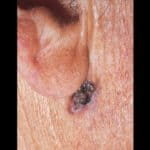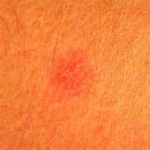What is Basal Cell Carcinoma?
Basal Cell Carcinoma is a type of skin cancer. Of all skin cancers, It is actually the most commonly diagnosed type here in the US. Usually, it shows up on the head, neck, shoulder, or back of the hands. Pretty much any area that gets frequent exposure to the sun is at risk. BCC is especially common on the nose. The disease is named after the skin cells it attacks. BCC growths arise in the skin’s basal cells. These are the cells that line the deepest layer of epidermis tissue.
What does BCC Look Like?
Typically, you can expect the appearance of shiny bumps, pink growths, open sores, or red patches. Initially, it will usually appear as a “pearly” bump that looks like a flesh colored mole. It might form into red patches or areas of the skin that appear to be scaly. If you’re in doubt always have any concerning areas evaluated by a Dermatologist. BCC could be life-threatening in rare circumstances if not treated.
Why should I get BCC Treated?
While typically the disease does not grow rapidly, if left untreated it can spread into surrounding areas. BCC can destroy skin, tissue, and even bone if not removed. While is it not typically life-threatening if treated, it can cause serious disfigurement if you wait too long to see a doctor. This cancer spreads deep into surrounding tissue, so you might not see its total progression with the naked eye.
What are some Treatment Options for BCC?
Surgery is the best option for treatment in most cases. If you have a BCC located on a sensitive area, such as the fac e or ear, we offer MOHS in-clinic here at Associated Dermatologists, which involves mapping the affected area with a microscope to determine the exact area of cancerous cells. This technique allows for minimal loss of healthy cells and has the highest cure rate.
e or ear, we offer MOHS in-clinic here at Associated Dermatologists, which involves mapping the affected area with a microscope to determine the exact area of cancerous cells. This technique allows for minimal loss of healthy cells and has the highest cure rate.
Another option that is typically reserved for smaller lesions is Curettage and Electrodessication. The cancerous growth is scraped off with a curette and then the tumor site is desiccated with an electrocautery needle. Cure rates for this procedure are reported to be above 95%.
Photodynamic Therapy is an FDA-approved method for the treatment of some types of BCC. A topical agent is applied to the lesion site, and the area is then exposed to a strong blue light in the doctor’s office. The topical solution is activated by the blue light, providing selective destruction of the BCC tissue. You must avoid sunlight for at least 48 hours after this procedure. Otherwise, you risk activating the topical agent again and causing severe sunburn.
Medications Used to Treat BCC
Aside from surgery, there are a few FDA-approved drugs used to treat some forms of BCC. Imiquimod cream is approved for use only on superficial lesions. It stimulates your immune system to produce interferon, a chemical that attacks cancer. 5-Fluorouracil is also a topical drug that has been approved to treat superficial BCC lesions. However, even with both of these, we cannot be certain that complete tumor removal has been achieved. With surgery we are able to examine the area under a microscope to ensure all cancerous cells have been removed. Surgery has a 99% or better cure rate, while Imiquimod cream only has an 80-90% cure rate.
How Can I Reduce My Chances of Developing BCC
First and foremost, avoid excess exposure to the sun! Seek shade between 10AM and 2PM when the UV exposure is the highest. Avoid tanning beds, and be sure to use a broad-spectrum sunscreen when spending extended periods of time outdoors. If you plan to be outside for a long time, use SPF 30 or higher sunscreen. Finally, you should examine your skin each month for signs, and see your doctor each year for a professional exam.
Reach out to Associated Dermatologists if you have any questions about BCC and treatment options. 205.853.3960
